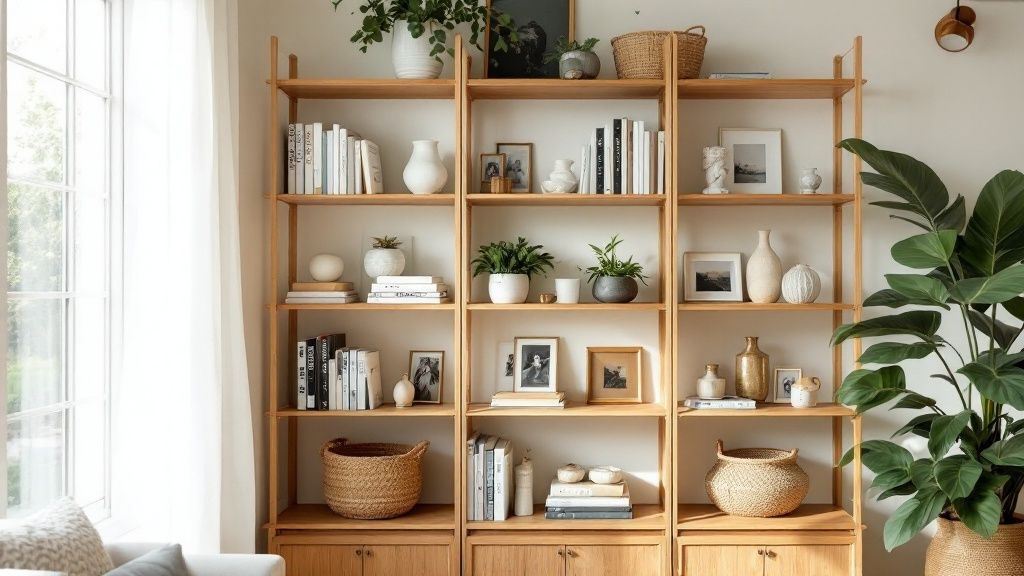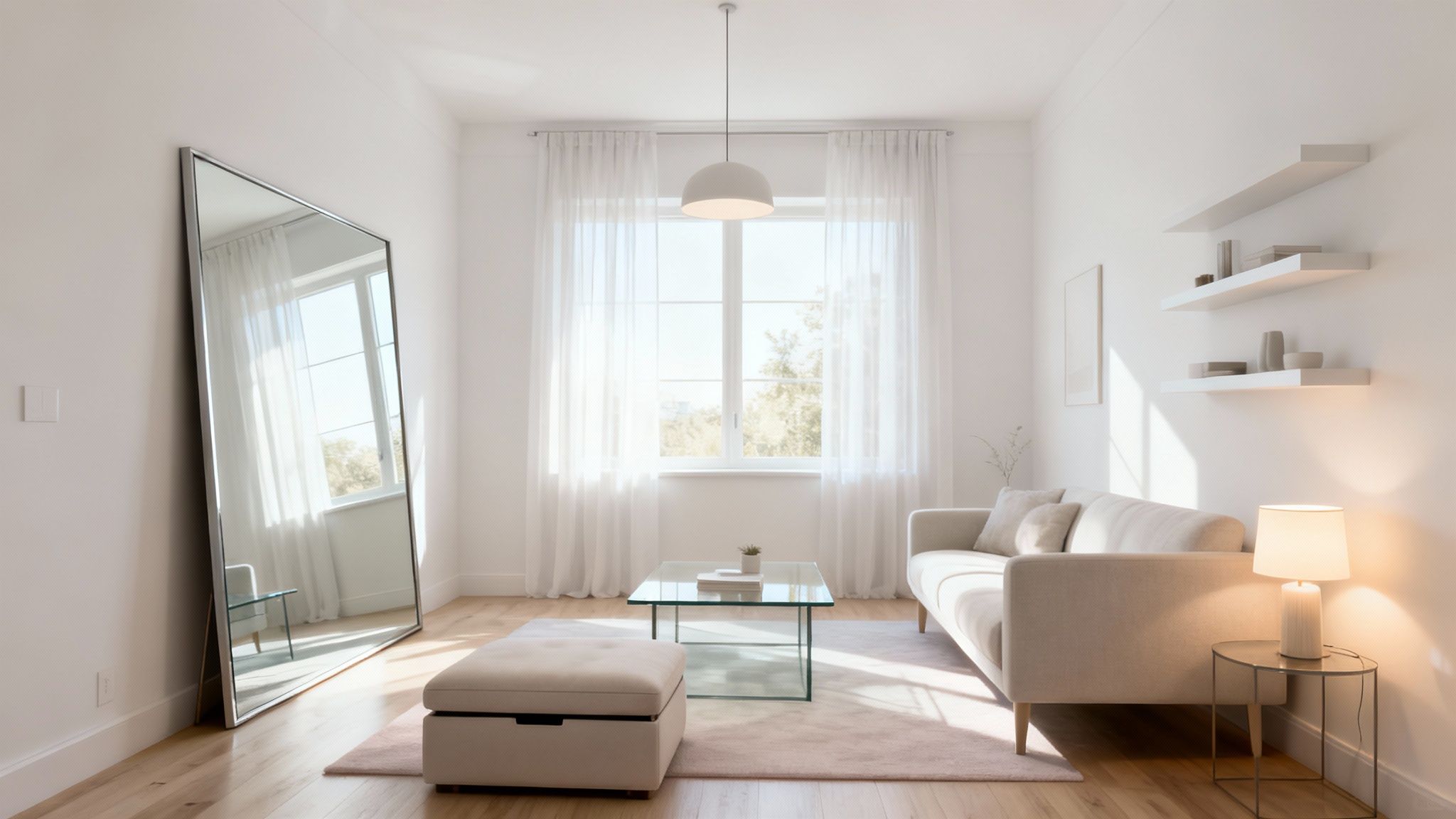Styling a bookshelf isn't just about finding a home for your books; it's an art form. It’s about creating a visually interesting display that balances your favourite reads with personal treasures and decorative pieces. The real secret I've learned over the years is to play with placement – mixing vertical stacks with horizontal ones, varying the height of your objects, and, most importantly, allowing for a bit of breathing room.
Your Bookshelves Are More Than Just Storage
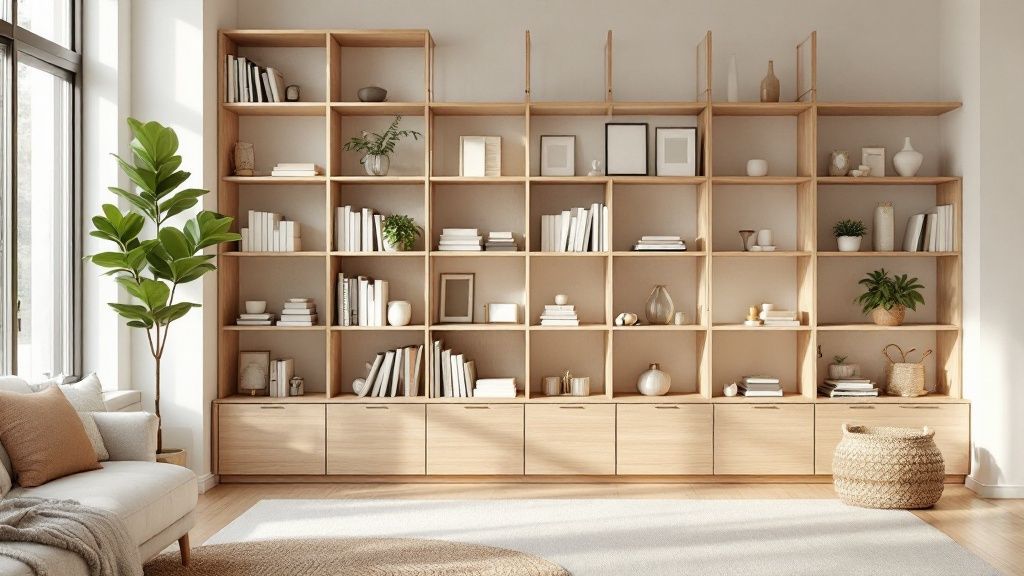
Let's be honest, bookshelves often become a dumping ground for clutter, rather than the stylish focal point they deserve to be. But with a little thought, you can transform them into a canvas that showcases your personality and pulls the entire room together.
This guide is about moving beyond simple organisation. We're going to dive into the core principles that interior designers use to create those perfectly curated "shelfies" you see in magazines.
A well-styled bookshelf should feel like a reflection of you. It’s not about generic decor; it's about showcasing meaningful objects that tell your story, turning storage into a statement.
This desire for furniture that is both beautiful and functional is a growing trend. In fact, the UK furniture market is projected to hit an estimated value of USD 14.73 billion in 2025, largely driven by our love for pieces that look good while serving a purpose.
Getting your shelves in order often sparks a desire to organise the rest of your home, too. If you're feeling inspired, you can find some fantastic inspiration in these clever storage ideas to build in while you renovate. By the time we're done, you'll have all the tools you need to style your own bookshelves to perfection.
Start with a Clean Slate and a Clear Vision
First things first: take everything off the shelves. I know, it sounds like a hassle, but trust me on this. You can't properly reimagine a space when you're just shifting the same old things around. A completely blank slate is the only way to break out of a rut and see the potential.
Before you even think about putting anything back, pause and think about the feeling you want to create. Are you after a calm, minimalist vibe? Or is your style more about a riot of colour and personality?
Having this clear direction is what separates a beautifully styled shelf from a random collection of stuff. You're aiming for a cohesive look that feels like a natural part of the room, not an afterthought.
Choose a Cohesive Colour Palette
Your colour palette is the secret weapon that will pull the whole look together. Take a good look around the room. What colours are already in play on your walls, sofa, or rugs? Your bookshelf should feel like it belongs.
Here are a few ways you can approach this:
- Monochromatic: Sticking to different tones and shades of a single colour creates a really sophisticated, calming effect.
- Analogous: Try picking colours that sit side-by-side on the colour wheel, like blues and greens. This gives a rich, layered feel that’s harmonious.
- Complementary: For a real pop of energy, pair colours from opposite sides of the wheel, like a deep blue with a burnt orange.
Nailing this down from the start makes choosing which books and objects to display so much easier. If you're looking for more ways to create a high-end look on a budget, we've got some great ideas in our guide to affordable interior design.
Refresh the Bookshelf Itself
While the shelves are bare, it’s the perfect opportunity to give the unit itself a bit of love. Is the paint looking a bit tired or scuffed? A fresh coat of a crisp white or even a moody, dark charcoal can make a world of difference.
Pro Tip: A really quick but effective update is to add peel-and-stick wallpaper to the back panel. It’s a brilliant way to bring in a splash of pattern or colour, creating a custom backdrop that makes your displayed items truly stand out.
Don't skip this prep work. By starting with a clean, refreshed canvas and a solid plan, you're setting yourself up for a final result that looks intentional, polished, and perfectly you.
Mastering the Art of Arrangement
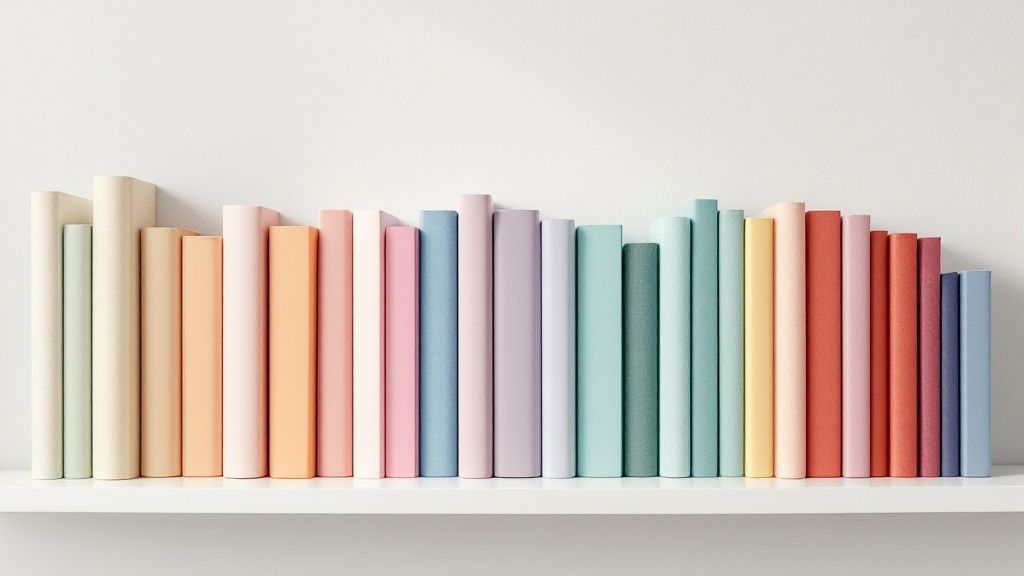
This is where the real fun begins and your bookshelf starts to take on a life of its own. The secret to a beautifully styled shelf isn’t just about what you choose to display, but how you arrange it. It’s the difference between a simple storage unit and a curated feature that tells a story.
A simple but incredibly effective technique is to break the visual monotony of endless vertical spines. Try stacking some of your books horizontally. These small stacks create rhythm and instantly add a bit of architectural interest. Plus, they double as perfect little pedestals for a treasured decorative object.
Create Visual Interest with Grouping and Depth
One of the oldest tricks in the design book is the rule of odds. When you're grouping decorative items, aim for clusters of three or five. For some reason, our eyes find odd-numbered groupings more natural and appealing than even-numbered ones, which helps create a more dynamic feel.
To build depth, think like you're setting a stage. Place taller, larger items—like a framed piece of art or a slender vase—towards the back of the shelf. Then, you can layer smaller, shorter objects in front of them. This simple trick creates a sense of dimension and stops your display from looking flat and one-dimensional.
A common mistake is pushing everything flush against the back wall. Pulling some items slightly forward and layering them creates a richer, more engaging display that invites a closer look.
This attention to stylish storage is more important than ever, especially in urban areas where every inch counts. In fact, the European shelving market is quite substantial, with the UK holding a significant 28% share of continental sales. This reflects a strong demand for clever solutions that blend function with style.
Anchor and Balance Your Display
To keep your vertical book collections from looking untidy or toppling over, use decorative bookends. They don't just provide support; they act as anchors that frame a collection, giving it a defined beginning and end. You can choose bookends that complement your overall theme—whether that's sleek metal for a modern look or rustic wood for a cosier vibe.
Getting the balance right is crucial for a polished finish, especially in compact areas. For more inspiration on making the most of what you have, check out our practical small space decorating ideas for tips that work in any room. These thoughtful touches ensure your shelves look balanced, purposeful, and effortlessly chic.
To help you get the mix just right, here's a quick guide to choosing a variety of objects that will bring your shelves to life.
Bookshelf Decor Item Selection Guide
Using a few items from each category ensures your display has a great mix of texture, height, and personal meaning.
Adding Personality with Texture and Personal Items
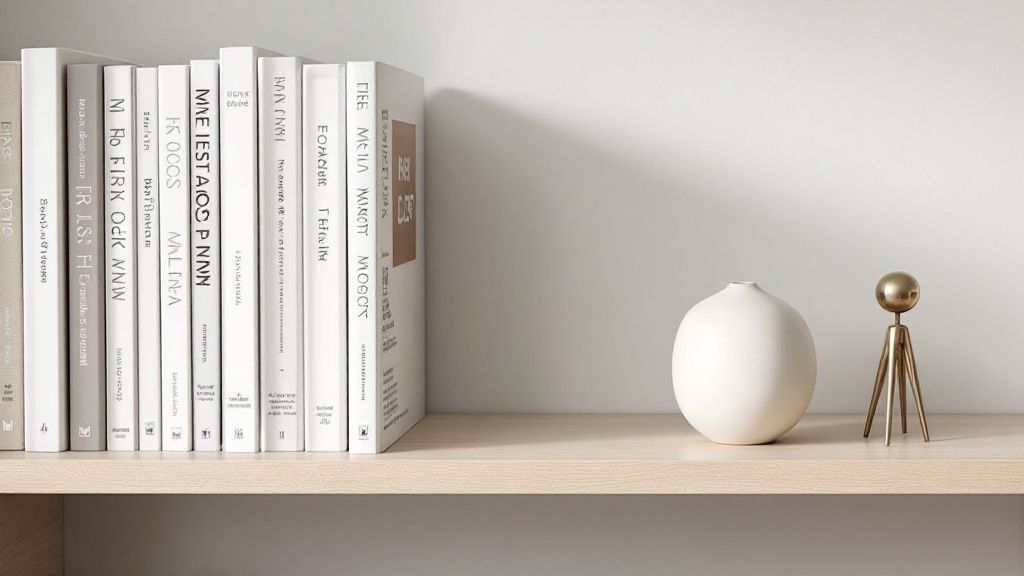
A truly well-styled bookshelf should feel like a genuine reflection of you, not something ripped from a catalogue. This is where you get to layer in personality and depth, transforming a simple piece of furniture into a storytelling centrepiece.
The secret is to create visual and tactile interest by mixing different materials. Imagine a smooth, cool ceramic vase placed next to the rough texture of a woven basket. This kind of contrast is what breathes life into a display, preventing it from looking flat or one-dimensional.
Forget generic décor from a big-box store. The most compelling bookshelves showcase meaningful objects: a treasured souvenir from your travels, a framed family photo, or a small piece of art that makes you smile. These items are the heart of your display.
Integrating these personal treasures is what makes styling a bookshelf so rewarding. The goal is to make it look curated, not cluttered, with each piece earning its spot.
Incorporate Natural and Varied Materials
Bringing in a mix of materials instantly adds warmth and character. A sleek metal photo frame, for example, can look fantastic beside a leafy green plant, creating a beautiful juxtaposition of hard and soft elements.
It's no surprise that wood remains a timeless choice for the bookshelves themselves, valued for its classic good looks and durability. In fact, it dominates a market valued globally at USD 14.5 billion in 2023. You can read more about the global trends in the bookcase market to see just why this natural material continues to be a staple in our homes.
Here are a few ideas for mixing up textures:
- Woven baskets: Perfect for hiding small, less attractive items while adding a lovely, natural feel.
- Glass and metal: Introduce a touch of shine and sophistication with a decorative bowl or a metallic object.
- Ceramics and pottery: These offer sculptural shapes and a whole range of finishes, from glossy to matte.
Weave in Your Personal Story
Your shelves should tell the story of who you are and what you love. Don’t shy away from displaying items that hold sentimental value—these are what make a space feel truly yours and create that welcoming atmosphere we all crave.
For more inspiration on making your house a haven, have a look at our guide on how to create a warm and inviting atmosphere with cosy home ideas.
By carefully selecting and placing items that genuinely matter to you, your bookshelf becomes so much more than storage. It becomes a curated collection of your life's highlights.
The Final Edit and Avoiding Common Styling Mistakes
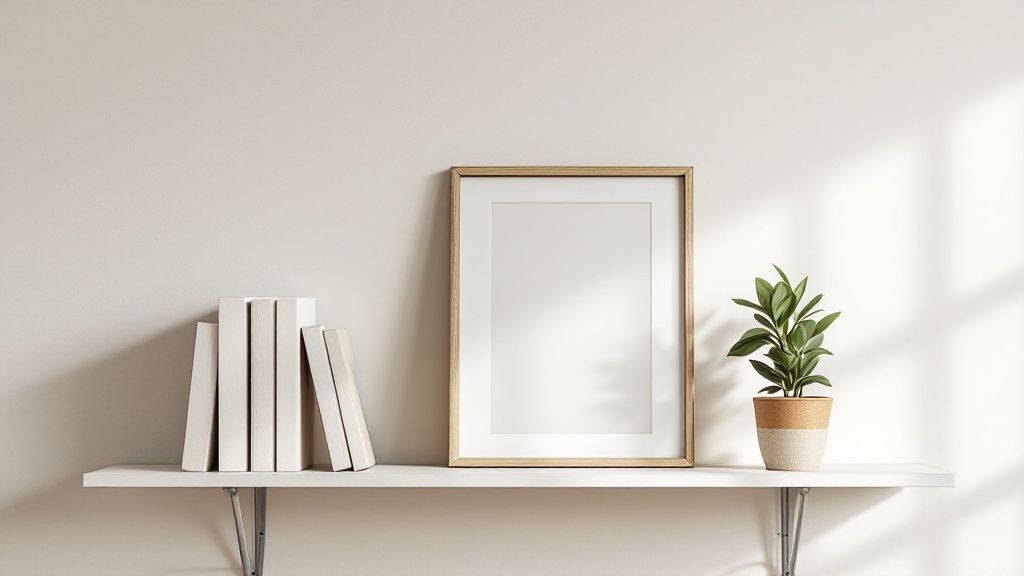
Knowing when to stop is just as important as knowing where to start. Once you've placed everything, the real magic happens in the final edit. Take a few steps back and really look at the whole composition. Try squinting your eyes – it blurs the details and helps you see the overall balance. Does one side feel heavier? Does a particular shelf scream "clutter"?
This is your chance to appreciate the power of negative space. Those empty areas around your objects aren't wasted; they’re essential. They give your favourite pieces room to breathe and stop the whole display from feeling overwhelming. A well-placed gap can have just as much impact as the items themselves.
This final once-over is also where you’ll spot any common styling slip-ups. A few small tweaks at this stage can elevate the entire look from 'nice' to 'professionally styled'.
Common Bookshelf Styling Blunders
Getting these final details right is a bit like home staging. Much like when you learn how to stage a home for sale, the goal is to create a scene that's both balanced and inviting. Keep an eye out for these frequent mistakes:
- The Tiny Object Overload: A crowd of small, fiddly items just looks like clutter from a distance. Try grouping them on a decorative tray or in a small bowl to give them more collective weight and presence.
- The Rigid, Uniform Row: Lining everything up like soldiers on parade can feel stiff and a bit lifeless. The key is to vary the arrangement. Mix vertical books with horizontal stacks and stagger the placement of your objects to create a more natural rhythm.
- The Single-Height Shelf: If everything on one shelf is the same height, the whole display can feel visually flat. You want to create a 'skyline' effect with a good mix of tall, medium, and short items.
By stepping back to edit, you shift from simply placing items to composing a scene. The goal isn't just to fill the space but to create a balanced, engaging display that feels effortless and personal.
A Few Lingering Bookshelf Questions
Knowing the principles of bookshelf styling is one thing, but putting them into practice in your own home often brings up a few tricky questions. It’s those little details that can make or break the final look.
I get asked about these specific challenges all the time, so let's tackle the most common ones head-on. Think of this as your personal troubleshooting guide for turning a good shelf into a great one.
How Do I Handle Mismatched and Colourful Book Spines?
Ah, the classic problem: a beloved but visually chaotic collection of books. My advice? Don't fight it, work with it. The quickest way to bring order to a jumble of colourful spines is to group them by colour. This creates a kind of intentional rainbow effect that instantly feels more organised and cohesive.
If that’s not quite your style, try this little trick: turn the most visually jarring spines inward so only the neutral-coloured pages are showing. You don’t need to do this with all of them—just a few here and there can provide a bit of visual calm and break up the busyness.
The secret to styling a diverse book collection isn't about creating perfect uniformity. It's about finding a visual rhythm. Grouping by colour or size brings a sense of deliberate order while celebrating the unique character of your library.
What Should I Do with Deep Bookshelves?
Deep shelves are a double-edged sword. All that extra space is great for storage, but it can feel like a black hole where small, beautiful objects go to disappear. The solution is to think in layers.
Start by creating a backdrop. Lean a piece of art, a beautiful platter, or even a shallow decorative tray against the back of the shelf. This immediately takes up some of that dead space. Next, place your taller items, like a vase or a vertical stack of books, in front of the backdrop. Finally, arrange your smallest treasures in the foreground. This layering gives the shelf dimension and ensures everything gets its moment in the spotlight.
A simple layering formula I often use:
- Back Layer: Something large and flat, like leaning art or a mirror.
- Middle Layer: Taller, substantial objects, such as a sculptural vase or your largest books.
- Front Layer: Shorter, smaller decorative pieces—think a beautiful candle or a small ceramic bowl.

